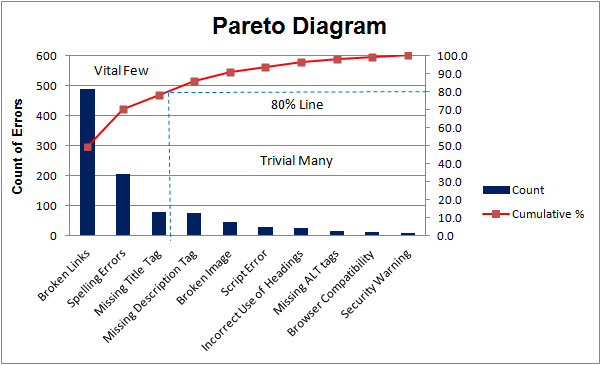What is Pareto Analysis? The 80/20 Rule for Success
Pareto analysis is based on the Pareto principle that states ‘20 per cent of the causes produce 80 per cent of the effects’.
This means that to understand the root causes of something, you must identify the 20 per cent of most influential factors that caused a certain outcome.
For example, suppose a certain outcome was to change people’s spending habits. In that case, we might find the 20 per cent of the most influential factors that cause people to spend, based on their personality and beliefs, spending behaviour, income, and so on.
Pareto Principle
The Pareto Principle, which is also known as the 80/20 rule, the law for life and sparsity, shows that 20%, or as a lamen, of your actions and activities account for 80% of your results and results, 80% are the consequence of 80% of the impacts. 20% are caused by 20% of your actions.
Pareto was an Italian economist and sociologist who observed that roughly 20% of the population controlled 80% of the land in Italy. This Pareto principle is alive and thriving in the quality and continuous improvement industry today. It is commonly acknowledged that a small percentage (20%) of causes account for 80% of problems.
Selecting the Best Solution With the Most Impact
Consider a situation in which you were promoted to department leader. You’re full of ideas about how things may be improved, but how do you begin?
Ideally, you would like to focus on resolving the most important concerns. But how do you determine to initially address which one?
Pareto Analysis is a basic method for deciding how to evaluate and measure the effect of conflicting challenges. This helps you to concentrate on solutions that benefit most. Keep these things in mind while implementing Pareto Analysis:
- Problems and tasks identify and prioritise.
- To help people more effectively arrange their tasks.
- Productivity enhancement.
- Profitability improvement.
Implementation of Pareto Analysis

Step 1 Problem Identification and List
Write a list of all the issues you need to fix. Collect feedback from customers and team members as far as feasible. This could take the shape of, for example, consumer surveys, official complaints or helpdesk records.
Step 2 Identify each problem’s root cause
Next, come to every problem’s fundamental cause. Tools for this are techniques like the 5 Whis, Cause and Effect analytics and Root Cause Analysis.
Step 3 Issues of Score
Now you can identify every concern you have listed. The technique of scoring you choose will depend on the type of problem you want to solve.
You may, for instance, find faults with how much it costs if you want to boost earnings. Or you might rate them depending on the number of complaints you received about each one if you are aiming to increase customer satisfaction.
Step 4 Together Group Problems
Use the root cause analysis done in step 3 to categorize issues by common cause. You may, for instance, include these in the same group if there are three difficulties caused by a shortage of workers.
Step 5 Add up Each Group Scores
Now, add the scores for every category you have identified. Your highest priority should be the one with the top score and your lowest priority the group with the smallest score.
Step 6 Action to Take
It’s time for action, finally! You will probably have the largest payout after your highest scoring problem is resolved, hence start thinking ideas about the first way.
You may find it interesting noting your lowest score problems, especially if they are exceedingly expensive to cure. To conserve your efforts and resources, use your Pareto Analysis.
What does a Pareto Chart tell you?
A Pareto Chart is a fundamental quality tool that may help you find the most common problems, complaints or any other aspect. The graphic draws its name from the creator of the ’80/20 rule,’ Vilfredo Pareto, which suggests that 20% of individuals have 80% of the wealth. In terms of quality, 80% of the losses are caused by 20% of the reasons.

The most common Pareto chart you will see online is a “bar chart”. There are two main ways that Pareto charts have been used. The first is to present the frequency of the factors and the second is to present a ratio. A Pareto chart is usually composed of bars (or rectangles). The vertical axis usually shows frequency, but it may be an impact ratio instead
Advantages of Using Pareto Analysis
Pareto analysis has multiple benefits and advantages. Pareto analysis helps one gain a deeper understanding of the data and the results helps in decision-making and provides information about the data that we can use to predict or make assumptions about the outcome of the analysis.
Some advantages of Pareto analysis are as follows:
- It’s easy to draw a Pareto chart.
- It allows you to separate issues and causes.
- It allows you to solve the few difficulties that create the greatest problems.
- It shows you the problems to focus on improving the most.
- It allows you to envision difficulties and is a great tool for visual communication.
Drawbacks of Pareto Analysis
The following are some Pareto analysis limitations:
- The Pareto principle is a thumb rule, in all instances, cannot be applied.
- It does not help you to locate the underlying cause. Hence you need another tool, such as an analysis of the underlying cause.
- If there are many difficulties, it might be necessary to separate additional sub-Pareto diagrams, which is sometimes difficult.
- It demonstrates a problem’s frequency, not seriousness.
- It concentrates on previous facts that may not be important to present or future circumstances.
Is a Pareto Chart Qualitative or Quantitative?
Qualitative data is represented through Pareto charts. A Pareto diagram is a vertical bar diagram in which the frequency or relative frequency is either the height of each bar. The bars are organized from left to right in decreasing order. Between the bars, gaps are employed.
Conclusion
The Pareto principle provides insight into the widest variety of phenomena, discriminating between those that are important and those that are not, identifying the most significant problems and their root causes, and so defining the direction of remedial activities (Mateides, 2006). This makes it a rational and meaningful instrument for making decisions. Other aspects are ‘insignificant’ and are typically not required to be addressed within a specific phase of problem resolution.

